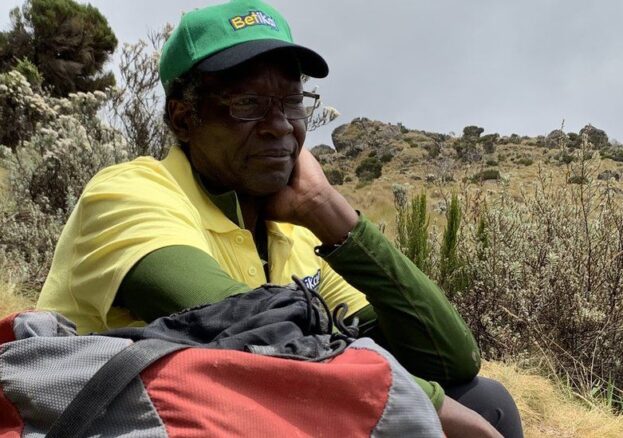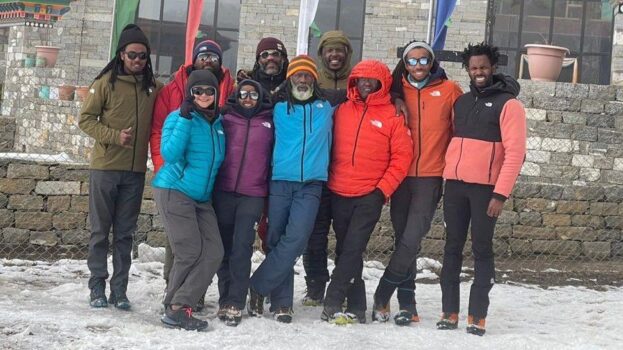
To date only 6,000 climbers are known to have conquered Everest since New Zealander Edmund Hillary and Nepalese Sherpa Tenzing Norgay became the first people to reach the summit in 1952. But fewer than 10 people of African origin are in this exclusive group. The Full Circle Everest team hopes to more than double that number.
They have just left base camp and hope to reach the summit in about two months.
At 62, James Kagambi is the oldest in the team of experienced mountaineers. He has summitted all the highest peaks in Africa, as well as the highest point in four continents, and hopes to become the first African to achieve all seven
He was the first black African to summit Denali (20,310 feet) in 1989 and was the first black African to summit Aconcagua in 1994. He’s done the Eiger (13,015) three times. He actively trains Kenya’s mountain rescue teams.
Most recently he had the pleasure of meeting Kenya’s president after carrying the 50th Anniversary flag celebrating the country’s independence to the summit of Mount Kenya.
“The main goal of our expedition is to encourage people of colour to go out, to venture into the mountains so that it’s not just white people out there. It is also to show people that they can do it because there are people who they feel like this is not for us [black people], it is for them,” he told the BBC before leaving for Nepal.
Although many Nepalese and Indians have climbed Everest – often as guides, mountaineering is often seen as a white person’s sport, especially in the West – something that Mr Kagambi grapples with in the US as a mountaineering instructor and guide.
It comes in the form of clients who don’t trust his skill because of his ethnicity.
“Before people realise what I have done, especially when I meet white people in the US, you see some people hesitating. Until you prove to them that you know what you are doing – that’s when they open up. I see that quite a bit,” he said.
The former primary school teacher fell in love with mountains in 1973 when as a teenager he watched in awe from his village at the midnight fireworks on the peak of Mount Kenya as the country celebrated its first decade of independence from British colonial rule.
“That was really unique and I remember saying: ‘I wish I can do that.’ But I never thought I would.”
Years later, after graduating from a teachers’ training college, he made an attempt on Mount Kenya and reached the summit.
“The first time I stepped on the snow, I knew that it’s something I really loved doing. And I kept going back and liking it more,” he said.
But his path to scaling Everest has been the steepest. On two previous attempts, being Kenyan was his undoing after American sponsors insisted that beneficiaries must be US residents.
“The last one was very close – like four months before the expedition – that’s when I was struck off. That was frustrating but rules have to be followed,” he said – a glimpse of the stoicism learnt from the mountains and which pervades his speech.
Climbing Everest isn’t cheap – up to $85,000 (£65,000) – and he had given up trying because age was catching up with him. Then an email in January 2021 from his American friend and fellow mountaineer Philip Henderson changed everything.

“My immediate reaction was that I wouldn’t do it. I told him that I’m too old and my knees are already not good on the mountains.”
But Mr Henderson insisted, pointing to reviews from other mountaineers who hailed Mr Kagambi as a guide who was “encouraging and supportive, especially to women”.
Getting admission into the team was the easiest hurdle. Finding sponsors proved the most difficult obstacle, as the traditional way of knocking on corporate doors proved futile.
“The hardest part for me was that I expected to work towards going to Everest in terms of training but I didn’t have the facilities and the finance to do that.”
Frustrated, out of funds and with no sponsorship, a breakthrough came through a WhatsApp group of his friends who were raising funds for the expedition. Contributions were trickling in slowly and there was little hope in sight.
Then word reached a Kenyan betting firm, which immediately offered a sponsorship deal, which covers Mr Kagambi’s training, travel allowance, insurance and operational logistics.
Part of his rigorous training regime has included scaling Mount Kenya six times from January to April. Tha was followed by a two-week expedition on the Rwenzori mountains in neighbouring Uganda.
Earlier, from July to December last year he was in the US and carrying 50kg bags while hiking for months and training students.
“I’ve been on the mountain all the time. Because of my knees, the best thing for me is to be out there hiking as high as I can for training,” he said.
His family is worried about his wellbeing, especially because climbing Mount Everest is such a dangerous undertaking.
“I really hope it goes well because at this point we know there are only two outcomes – it’s either he goes and comes back, or he goes and doesn’t come back. There’s that anxiety, there’s that fear, but we don’t want to show him,” his daughter Cynthia said.
But Mr Kagambi seems unfazed and defiantly declared that he had done riskier things in his life. He also pointed to his long experience of navigating through snow, glaciers, ice and rocks.
“I’m confident of summitting Mount Everest, but the other thing I say is – I will not put my life at risk to do it. I have done enough mountaineering to know my body. I can assess and tell myself it’s time to go back,” he said.
“I’ve been on the mountain all the time. Because of my knees, the best thing for me is to be out there hiking as high as I can for training,” he said.
His family is worried about his wellbeing, especially because climbing Mount Everest is such a dangerous undertaking.
“I really hope it goes well because at this point we know there are only two outcomes – it’s either he goes and comes back, or he goes and doesn’t come back. There’s that anxiety, there’s that fear, but we don’t want to show him,” his daughter Cynthia said.
But Mr Kagambi seems unfazed and defiantly declared that he had done riskier things in his life. He also pointed to his long experience of navigating through snow, glaciers, ice and rocks.
“I’m confident of summitting Mount Everest, but the other thing I say is – I will not put my life at risk to do it. I have done enough mountaineer
